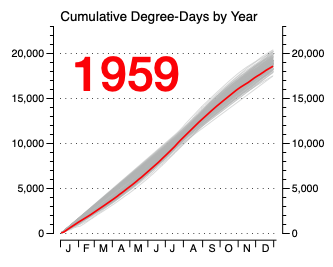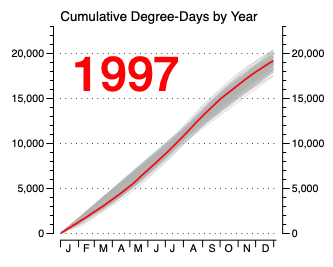California is in the midst of a wet and snowy winter. It sounds as if more is due this coming week. Although the copious amounts of rain and snow have wreaked havoc in some places, after several years of drought, this influx of moisture was very much needed.
Not much in the way of charts to show here on this initial post on California. But I’ll post two charts. The data comes from the National Oceanic and Atmospheric Administration’s (NOAA) National Centers for Environmental Information (NCEI) site where you can download historical climate data records for most major weather stations in the United States.
The data shown below is for San Francisco International Airport and ranges from July 1, 1945, through the present. I plotted these charts using a water year calendar. The water year calendar is a convention often used when plotting precipitation or snow data because on the West Coast these are typically cyclic or seasonal events. Most precipitation events fall during 4-6 months of the year beginning in October. This is true up and down the coast, though the precipitation season typically longer in higher latitudes. Therefore, the water year calendar typically runs from October 1 through the following September 30 to encapsulate the data for an entire season, which traditionally spans across two standard calendar year-dates. So, for the current water year, data is included from Oct 1, 2022, through September 30, 2023. This span is referred to the 2023 water-year (WY), as nine months of it exist in 2023.
I disregarded the early data period from July 1, 1945, to September 30, 1945, since it only represents a small part of the 1945 WY.
***
Figure 1 is called a dot plot and it shows the total accumulation of precipitation for each WY from 1946 to 2023. The current water-year is only partially complete. The data has been sorted showing the rainiest water seasons on top. I’ve highlighted the current 2023 WY in red. I’ve also highlighted the previous nine water seasons in blue. You can see much of the period between 2014 and 2021 were dry years though 2015-16 were close to the mean for total rain. The 2022 and 2019 seasons were also relatively close to the mean for annual precipitation. The 2017 WY, now six years past, was quite wet (for San Francisco). This year is so far close to the mean, but we are only five months into the water-year. But those are the wettest five months.
Figure 2 is a short animation (~30 sec.) which shows a cumulative precipitation trace across the water year of each year from 1946 to 2023 (through March 2, 2023). It can be seen from this chart that year-to-year, (a) the basic pattern is the same (lots of rain early followed by a long dry spell until October, and (b) the total amount of annual rainfall varies widely. And playing the small animation through there doesn’t appear to be a year-to-year trending pattern other than what was mentioned in the previous paragraph.
Helpful hint: Clicking on the gear wheel in the lower playback element allows you to slow or spead the animation playback rate.
Figure 2. Precipitation traces for San Francisco International Airport, 1946-2023 (current). Traces are displayed one at a time and follow the water year calendar starting on October 1 and ending the following September 30. The water year number takes on the year value for the January to September dates.


















































































